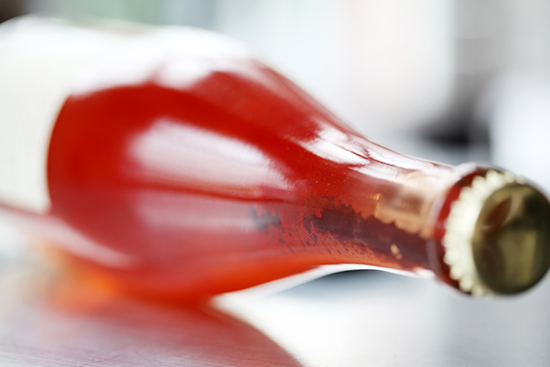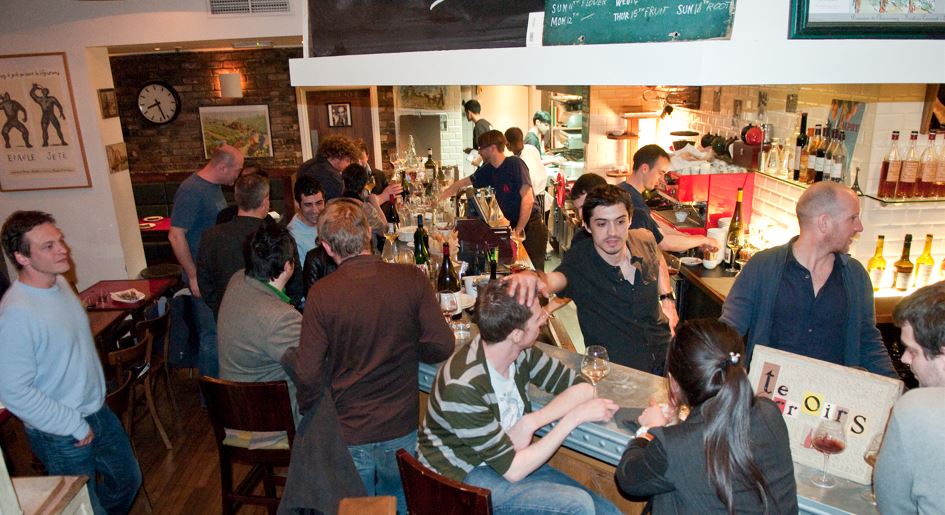The brief history, the culture, the arguments and the current state of play in the U.K.
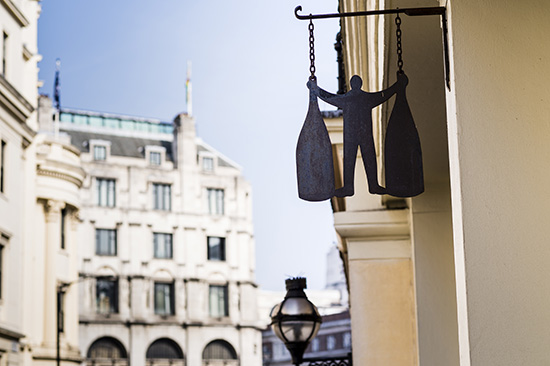
I was directed by a friend recently to an article describing the nature of the transition of the London natural wine scene from its naïve origins into something more grown up and considered. The premise (if not the article itself) was undercooked, for it presupposed that there once was – and has been ever since – a monotheistic definition of natural wine, wherein the proponents of such wines are also puritanical apostles of zero-sulphur and are relaxed when joyless funkiness trumps drinkability.
The writer solicits the views of various opinion formers (I think that is the term) who, shall we say, note the existence of natural wines but are somewhat guarded in their enthusiasm for them. For a more balanced perspective, the writer in question might have more usefully interviewed any one of a host of restaurateurs and buyers who work unapologetically and enthusiastically with natural wines, and who might also have given a clearer insight into the energy and innovation of the natural wine scene.
Nothing has had a more dynamic impact on all of wine culture in the last decade than the rise and continuing growth of natural wine.
Understanding its cultural context might enable us to more fully understand the natural wine phenomenon. I use the last word advisedly, because nothing has had a more dynamic impact on all of wine culture in the last decade than the rise and continuing growth of natural wine. If that smacks of hyperbole, consider the evidence: the current number of natural wine importers, the proliferation of wine bars, restaurants and retailers specialising in these wines, the constant noise on social media, the wine web sites, groups and blogs devoted to it, and the frequency of articles written on the topic (even if occasionally misguided).
For years, wine trade sceptics have been prophesying for that the nat bubble would eventually burst, yet the natural wine “movement” has proved to be more than resilient, neither niche, nor a quaint irrelevance, instead a fascinating and galvanic addition to the staid old wine world as we know it.
Low-intervention winemaking and farming arose as a reaction to industrial farming and winemaking that was producing high-volume, homogenous, chemically-corrected beverages, as well as to those luxuriant boutique wines designed to flatter the tastes of certain “influential” critics. Formerly known as “Parkerised wines.” Consumers were given a binary choice. In either case, industrial or boutique, the wines might be described as faultily faultless, icily regular, splendidly null, dead perfection no more, divorced from origin – as I am fond of saying. Meanwhile, natural vignerons (vignerons not winemakers, mind), by working without chemicals in the vines and the winery, and by stripping away superimpositions and technical tropes, were themselves crafting wines that majored on drinkability, purity and enjoyability. Which is not to say that such wines couldn’t also be complex, detailed and layered. Each vigneron, doubtless, had his or her specific influence or mentor, or felt impelled to make wine in a particular way. As a natural vigneron, one is always going to try to make wines consistent with one’s personality and beliefs, whilst the role of the vignerons is largely to accompany (my italics) the wine on its journey from grape to bottle with minimal intervention.
Natural wine has never been about style over substance. The reverse, in fact. For all that we debate the dos and don’ts of winemaking, any discussion of natural wine must begin with a description and assessment of the quality of activity in the vineyard. Although there is a spectrum of interventions, there’s a stark contrast between conventional chemical approaches and natural (organic, biodynamic, sustainable and regenerative) ones. Respecting nature and the natural process may sound obvious, but it takes dedication, patience and time, and involves being hands-on (even when one is being hands-off). Too much writing on the subject characterises natural wine as a de facto brand and a particular winemaking approach, rather than understanding that the wines are the living product of conscientious farming.
Speaking of branding (if we must). The growth of natural wine in the U.K. has been achieved without flimflam marketing and a minimum of hype. One might justifiably assert that the critics of natural wine have given the movement the maximum oxygen of publicity by creating a furore about the subject. As a result of sales success, it might conceivably appear to some that all along there was some ingenious/devious plan to bring these forgotten bottles into the public domain. A simpler explanation might perhaps be that the wines are popular because they are fun/delicious/interesting, and people (trade and consumers) like to talk/share their experiences of products that they like to consume. Too many articles about natural wine are written with the assumption that there had to be a trend (for why else would natural wine be successful?) and, by that logic, certain individuals (importers and sommeliers) had conspired to make it trendy and cash in on the temporary craze. There are many reasons for drinking low-intervention wine (ranging from the taste to the idea of supporting artisan producers), but attributing their popularity as being swept up into a trend betrays a lack of insight as much as it does a lack of faith in individuals to make their own determinations about what they like to consume.
The growth of natural wine in the U.K. has been achieved without flimflam marketing and a minimum of hype. One might justifiably assert that the critics of natural wine have given the movement the maximum oxygen of publicity by creating a furore about the subject.
Let’s return to the origins of natural wine. The natural wine family tree has several branches. I am not sure when exactly the term Vin Natur came into parlance as a catch-all to describe wines made in the low-intervention way, but the expression has probably been around for thirty years or so. (I am happy to be corrected on this!). The actuality of natural winemaking dates back thousands of years when wine was a part of everyday existence rather than a product to be judged on its merits. In more recent times, Jules Chauvet, scientist, writer and winemaker, is considered one of the progenitors in France, his influence on Marcel Lapierre and the so-called “Gang of Four” in Beaujolais heralded a being instrumental in instituting a methodical approach towards low-intervention winemaking. These producers (Lapierre, especially), in turn, influenced a group of Burgundy and Jura vignerons, not to mention the likes of Eric Pfifferling, JF Nicq, Dard & Ribo. Elsewhere, biodynamics was being systematically applied to vine-growing. With Nicolas Joly and Mark Angeli in the vanguard. While each region had its outliers and its dudes and dudesses and popes and popesses doing it for themselves, organisations such as Demeter, Biodyvin and Renaissances des Appellations were being created to lay down guidelines and bring together families of vignerons from various regions and countries under their respective umbrellas. Meanwhile, smaller wine fairs were being formed for likeminded and like-practising producers to exchange ideas, to show solidarité, and to party! If one were to generalise about the natural wine family tree in France, one might say that there was a Beaujolais family, at least one Loire family, a Jura family, later an Alsace one also. Some of these branches subdivided further, and many of the families came together for larger fairs or split further to do more intimate events. One cannot talk about the history of natural wine without mentioning Sylvie Augereau who took over the organisation and running of La Dive Bouteille, which itself grew from a tiny handful of growers into a huge festival of two hundred-plus natural producers from across the world (but mainly France), and which spawned several salons.
And this is just France. Italy was establishing its own natural wine scene, just as diverse and just as political.
Like the everyday world, the artisan wine world has been riven by factionalism and disagreements about interpretation. This is more to do with argumentative and bureaucratic human nature than the subject at hand. What’s a few grams of SO2 between friends? Sometimes quite a bit as it happens. Some producers are keen on having benchmarks and manifestoes, others believe that that is against the spirit of natural wine. Vignerons are made to jump through so many hoops to prove that they are doing what they are doing – the organic hoop, the biodynamic hoop, the natural hoop. Probity and integrity are forever being evaluated.
The subject deserves to be tackled with common sense both from within and without the natural wine community. The growers are the growers. The wines are the wines. The vintages are the vintages. The decisions are the decisions made at the time. Which is why it is frustrating to read someone trivialising natural wine by focusing on the fault lines, rather than understanding that every wine is an individual test case – for itself. It is not just the two proverbial snowflakes that are not identical. Natural wine embraces singularity and mutability to its very core. In this sense, the wine is a microcosm of circumstance and of nature itself.
Natural wine obviously is not an idea that occurred overnight. A switch was not flicked, a multitude of simultaneous Damascene conversions did not happen. As an idea, it was never a single fixed position about what wine should be, rather the rough convergence of congruent farming and winemaking approaches which was labelled by writers, commentators, importers, sommeliers) as natural. As well as the wine fairs alluded to above, it was Paris where the heart of natural wine beat mostly strongly, where the wine bars and cavistes of the city had a direct line to the vignerons who came and sold their wares.
And so to the wine culture of the UK. At the one end, supermarkets possessed immense power and affected perceptions of quality and value, were able to rig price points, squeeze producers. Volume and consistency (to the point of homogenised-pasteurised wines) were the watchwords of the wine buyers. There was a dearth of interesting wine bars. With a few honourable exceptions, they tended to peddle bland brands and dreary common denominator wines. And upmarket restaurants hawked their extensive digests of classic Bordeaux, Burgundy, Italian and Californian wines.
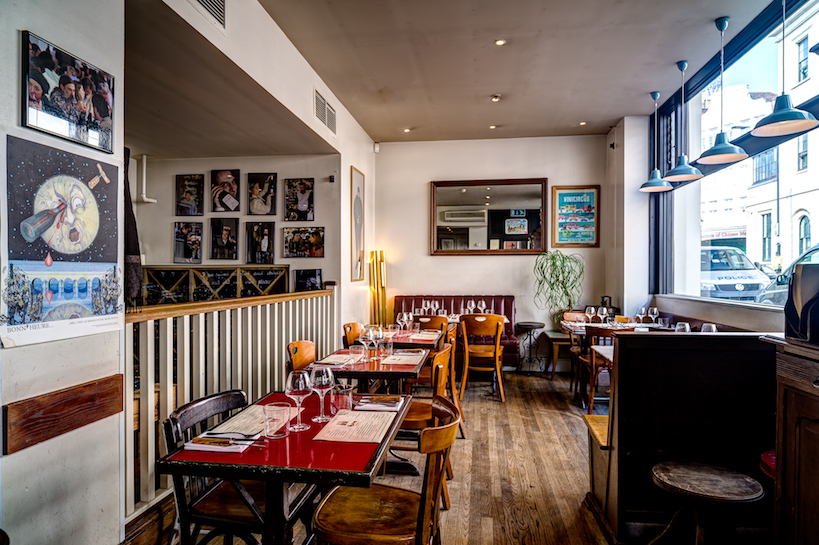
We were never “on-trend” at Les Caves. The medium was the wine and the wine was the message. Which meant that being perceived as trend-setters (or outliers) because of the natty wine hoo-ha was agreeably shocking. When everyone seemed to be talking about grape varieties, we were bleating about the seemingly alien concept of terroir. Whilst we were excited to sell wines made from organically-grown grapes and fermented with their own yeasts, others were still religiously quoting scores in the Wine Advocate or Wine Spectator. Our first wine bar, Terroirs, was not an attempt to cash in on the natural wine movement. We really loved those thrilling wines we had encountered in various Parisian establishments. Natural wine – as a concept even – simply did not exist in this country. And seriously, what difference could one small wine company make with almost no cash, opening a restaurant/bar in central London with wines no-one had ever heard of during one of the worst recessions in thirty years? The bases were loaded with empty prospects! No, Terroirs was the natural (that word!) result of our deep desire to have a friendly bar in central London, goddammit, a place where we could drink and entertain people, one where anyone could walk in and glug delicious, interesting wines and eat well-cooked unpretentious food at a super-affordable price. We had decided to focus on natural wines as they were what we wanted to drink (and therefore share with others).
A good proportion came from the trade initially, from sommeliers, managers to chefs, some to witness what the fuss was all about, others simply to chill out with Ed Wilson’s incomparable pork and pistachio terrine and a glass of something red and naughty.
After the first few people through the door (under the misapprehension that our place was simply a refurbed incarnation of the previous wine bar) discovered that this particular wine establishment wasn’t dispensing milquetoast Pinot Grigio accompanied by slug-‘n’-lettuce sarnies (garlicky snails on toast, if you please) anymore, a new curious and venturesome crowd trickled in. A good portion of the trade came initially, from sommeliers, managers to chefs, some to witness what the fuss was all about, others simply to chill out with Ed Wilson’s incomparable pork and pistachio terrine and a glass of something red and naughty. The momentum built. Reviews were enthusiastic. Parties spontaneously broke out on more than one evening as tables merged, wine bottles were exchanged and new friendships forged. The buzz was palpable. People would queue half way down the street just to get a glass of crazy wine and to cut the atmosphere with a knife.
On one particular evening, ensconced at the bar, with panting customers lined three deep behind me, I witnessed how carafes of (mainly) cloudy amber liquid were circulating between tables in the restaurant as if borne on gusts of copinage. There was a low background roar of enjoyment and intense gratification. I thought at the time “this is really happening. This is natural engagement.” Or words to that effect. Whether the wines were in the foreground or the background, they were very much in the picture. Wine culture tangibly unfolding.
Whether this was the genesis of an awareness of natural wines in the UK, a natural birth achieved without the support of ‘marketing, ‘gramming or hype, is debatable. The wines were now undoubtedly on the map and on the lips (if not in the mouths) of people in the wine trade and the gastronomically-curious consumer. Those who didn’t understand the success of the natural wine bar dismissed it as a trend even a flash-in-the-pan or sneered that it was hipster fad. Natural wine bars were never meant to be clubs or cliquey establishments for the funk-muddled cognoscenti. The best venues encourage experimentation and don’t browbeat customers into drinking a wine that they would rather not.
Terroirs opened in October 2008, and at that time was the only place in London where one might drink a wide selection of organic, biodynamic and low-intervention wines. Some fantastic people worked there and went on to open their own natural wine establishments: Renato & David (The Remedy); Margaux (Naughty Piglets); Damiano (who went to Brawn and then on to form Tutto Wines with Alex).
You can’t write a serious article about natural wine in the UK without referring to the Natural Wine Fair (2011) and successor tasting events. After three small dummy runs, the Natural Wine Fair was a coming together of like minds – five wine companies x Isabelle Legeron. Two and half thousand people (trade and consumers) attended, 115 producers poured their wines. The event felt revolutionary. The following year, two artisan fairs emerged: The Real Wine Fair and RAW. Over the next decade, these brands were to develop their respective (but not dissimilar) identities and attract many hundreds of growers and tens of thousands of visitors not just from this country but from across the world. The spirit of natural wine is to be found here and elsewhere in the dozens of smaller artisan fairs and tastings that take place during the year.
Back to our article on natural wine and the implied thesis that many dog wines (the result of bad winemaking or dogmatic adherence to a no-sulphur-added regime), have had their day and the assertion that more restaurateurs, sommeliers are now attuned to faultiness. Ergo, our wine culture is more discriminating. This is a simplification. There are more natural wines available than ever before, many hundreds, even thousands, and, as a result, both more good wines and more bad wines.
I don’t subscribe to the idea that buyers are more sophisticated now. The main difference now, as opposed to ten years ago, say, is the intrusion of market forces into the natural wine world. Once upon a time, we could have bathed in a Jurassic lake of Ganevat or Cavarodes. Now we share out the allocations with an eye dropper. Many accounts understandably wish to acquire natural wines with a hefty reputation (and won’t even entertain new or less famous names) to adorn their lists. This perpetually increasing demand and diminishing supply has driven prices skywards. Growers realise that they are in possession of a commodity and are increasing their prices to the importer. And thus the vicious circle is created.
A wine culture is not sophisticated if the overriding intention to have the best wine list by means of building a cellar of rare (and barely affordable) wines to garner recognition and wine awards rather than finding delicious affordable artisanal wines for your clientele. Natural wines have become a luxury commodity, a draw, a signifier to symbolise that wine is taken very seriously in an establishment. I may sound like an idealist but I believe that beautiful wine should be shared, not marked up to an astronomical price just because some people might fork out that amount of money for a famous wine. Too many restaurants forget that a wine is also a drink for the people, not just for the deep-walleted or the collector. The natural wine philosophy has fundamentally always been copinage, that the function of any bottle is to be opened and drunk amongst friends.
As a buyer, Eric’s sense of taste is still our reference today at Les Caves…He sees the wines for what they are, and has both the most intuitive yet rigorous palate I know.
Any article that purports to be a considered examination of the London wine scene should certainly know who the real heroes are. You should begin with Eric Narioo of Les Caves de Pyrene (he would deprecate the spotlight, but take Andrew Jefford’s word for it in this Decanter article), but without his drive and vision, Terroirs and the natural wine bars would never have come about and Les Caves de P would never have been mover and shaker in the natty wine world. Not that we styled ourselves as such. Those were the wines that Eric bought. As a buyer, his sense of taste is still our reference today at Les Caves. Now he and Anna Martens make superb natural wines on the foot-slopes of Etna. He sees the wines for what they are, and has both the most intuitive yet rigorous palate I know.
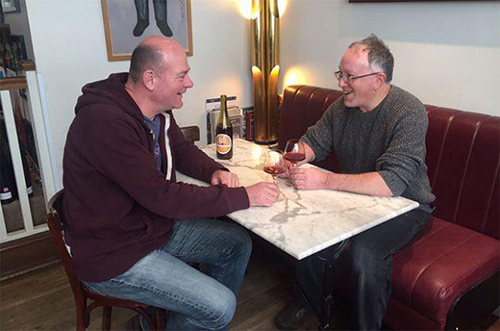
Not mentioning the host of small importers who have help to put natural wines on the UK wine map and persuade wine buyers and sommeliers to list them would also be remiss. Here is my selection: Fred Grappe (Dynamic Wines), Alex & Damiano (Tutto Wines) and Raef (Gergovie), Rafa (Vine Trail); and Ben Henshaw (Indigo). Major players now would be Under The Bonnet, Modal Wines, Newcomer Wines, Roland Wines, Otros Vinos, Beattie & Roberts and Carte Blanche wines. Now there are probably around 40 importers working directly with mainly natural vignerons and there isn’t space to name them all. Other champions of natural wine would include buyers, sommeliers and bloggers such as Chrissie Rasmussen, Honey Spencer, Heidi Nam Knudsen, Sarah Wright, Emily Harman, Federico Carafoli, Mattia Bianchi, Ed Wilson and many more. When you talk to these people you find that there is no ego, no desire to be hypercritical, just an appreciation for lovely low-intervention wine and sharing knowledge (and wine) freely with others. Each person is drawn to the wines through enjoyment of taste or loving the people behind them (and usually both).
Now there are probably around 40 importers working directly with mainly natural vignerons.
I can remember a time when no U.K. journalist would touch the subject of natural wine with a barge pole (or a very long pen) other than Jamie Goode. Indeed, it was difficult to get any writer to acknowledge its existence. A friend of mine wanted to do her MW dissertation on natural wine, but was informed that it couldn’t be allowed as no definition of natural wine existed. In 2020, I was invited to host a seminar for the Dip Ed on the topic of natural wine. Now dissertations are allowed. There is, of course, plenty to write about. And always has been.
The wine scene is constantly – and naturally – evolving. There is certainly more great natural wine out there than ever. And an ample sufficiency of undrinkable and faulty stuff. There are more delightful and knowledgeable people working in our industry than ever. On the flip side, I feel there is perhaps less energy and excitement than previously (I am not sure how you would quantify that); that profit margins rule; that there is a kind of natural wine snobbery (or is it reverse snobbery); and that all this conspires to thwart risk-taking and adventurous selling. The most positive aspect about the evolving scene is the sheer number of outlets in both on and off trade where you can buy natural, and that the phenomenon has spread far beyond London.
Importing, selling and writing about natural wines has taught me a few lessons over the years:
The first is not to generalise and invent a scenario that supports an unproven thesis. There are tens and thousands of wines, many hundreds of vignerons, and so many responses to these wines on a given day, at a given time. A wine that may show beautifully in one moment, may be awful in another. The second is to embrace the inherent contrarianism of wines being inconsistent. I don’t blame conventional winemaking methods for wines failing to live up to my expectations (how many times have I opened a bottle of classic Burgundy/Bordeaux and been sadly disappointed – far too many is the simple answer). The point is not to blame respective wine methodologies for specific outcomes.
My views have, of course, evolved over the years, doubtless as a result of drinking thousands of bottles of what I would call natural wine. As one who is condemned to be free, I am resigned to be philosophical. In the early days, I fought for the very idea of natural wine, the right to believe and assert positively that vignerons could make beautiful wines without chemical interventions. Invariably (or in my experience), the best bottles have been full of unfiltered goodness, free of additions and handled with gentle respect. I don’t believe in natural wines as an abstract concept (although I am comfortable grouping wines together under the broad banner); I do believe in the evidence of what is in the glass. I am convinced that what makes a wine appeal to us is the combination of so many shifting factors that one can only write intelligently about the subject if one is truly in tune with the subtleties of flavour, the context of drinking, and one’s emotional and critical state at the time.
Those that write about natural wine tend to fall into two camps. The first one features those who sarcastically disparage vignerons who make the stuff, merchants who sell it, and drinkers who drink it. We are all apparently drinking faulty wine and swallowing the hype. Then there is the “yes, but…” brigade suggesting that natural wines are a pimply interlude in wine history, a “taste phase” that undiscriminating drinkers go through before wising up. This is old hat. If you are going to write a sensitive and insightful piece on natural wine, then why not try wines from different producers and a spectrum of styles first, interview those people who really know the subject and research the history and culture of the natural wine movement.


